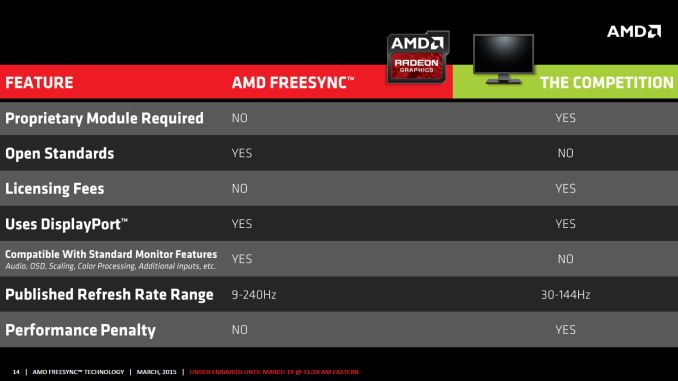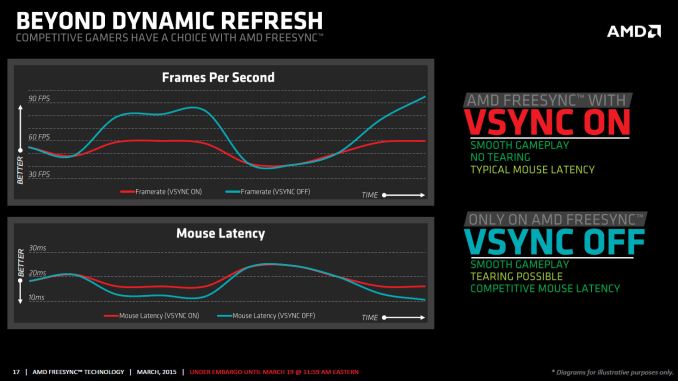The AMD FreeSync Review
by Jarred Walton on March 19, 2015 12:00 PM ESTFreeSync Features
In many ways FreeSync and G-SYNC are comparable. Both refresh the display as soon as a new frame is available, at least within their normal range of refresh rates. There are differences in how this is accomplished, however.
G-SYNC uses a proprietary module that replaces the normal scaler hardware in a display. Besides cost factors, this means that any company looking to make a G-SYNC display has to buy that module from NVIDIA. Of course the reason NVIDIA went with a proprietary module was because adaptive sync didn’t exist when they started working on G-SYNC, so they had to create their own protocol. Basically, the G-SYNC module controls all the regular core features of the display like the OSD, but it’s not as full featured as a “normal” scaler.
In contrast, as part of the DisplayPort 1.2a standard, Adaptive Sync (which is what AMD uses to enable FreeSync) will likely become part of many future displays. The major scaler companies (Realtek, Novatek, and MStar) have all announced support for Adaptive Sync, and it appears most of the changes required to support the standard could be accomplished via firmware updates. That means even if a display vendor doesn’t have a vested interest in making a FreeSync branded display, we could see future displays that still work with FreeSync.
Having FreeSync integrated into most scalers has other benefits as well. All the normal OSD controls are available, and the displays can support multiple inputs – though FreeSync of course requires the use of DisplayPort as Adaptive Sync doesn’t work with DVI, HDMI, or VGA (DSUB). AMD mentions in one of their slides that G-SYNC also lacks support for audio input over DisplayPort, and there’s mention of color processing as well, though this is somewhat misleading. NVIDIA's G-SYNC module supports color LUTs (Look Up Tables), but they don't support multiple color options like the "Warm, Cool, Movie, User, etc." modes that many displays have; NVIDIA states that the focus is on properly producing sRGB content, and so far the G-SYNC displays we've looked at have done quite well in this regard. We’ll look at the “Performance Penalty” aspect as well on the next page.
One other feature that differentiates FreeSync from G-SYNC is how things are handled when the frame rate is outside of the dynamic refresh range. With G-SYNC enabled, the system will behave as though VSYNC is enabled when frame rates are either above or below the dynamic range; NVIDIA's goal was to have no tearing, ever. That means if you drop below 30FPS, you can get the stutter associated with VSYNC while going above 60Hz/144Hz (depending on the display) is not possible – the frame rate is capped. Admittedly, neither situation is a huge problem, but AMD provides an alternative with FreeSync.
Instead of always behaving as though VSYNC is on, FreeSync can revert to either VSYNC off or VSYNC on behavior if your frame rates are too high/low. With VSYNC off, you could still get image tearing but at higher frame rates there would be a reduction in input latency. Again, this isn't necessarily a big flaw with G-SYNC – and I’d assume NVIDIA could probably rework the drivers to change the behavior if needed – but having choice is never a bad thing.
There’s another aspect to consider with FreeSync that might be interesting: as an open standard, it could potentially find its way into notebooks sooner than G-SYNC. We have yet to see any shipping G-SYNC enabled laptops, and it’s unlikely most notebooks manufacturers would be willing to pay $200 or even $100 extra to get a G-SYNC module into a notebook, and there's the question of power requirements. Then again, earlier this year there was an inadvertent leak of some alpha drivers that allowed G-SYNC to function on the ASUS G751j notebook without a G-SYNC module, so it’s clear NVIDIA is investigating other options.
While NVIDIA may do G-SYNC without a module for notebooks, there are still other questions. With many notebooks using a form of dynamic switchable graphics (Optimus and Enduro), support for Adaptive Sync by the Intel processor graphics could certainly help. NVIDIA might work with Intel to make G-SYNC work (though it’s worth pointing out that the ASUS G751 doesn’t support Optimus so it’s not a problem with that notebook), and AMD might be able to convince Intel to adopt DP Adaptive Sync, but to date neither has happened. There’s no clear direction yet but there’s definitely a market for adaptive refresh in laptops, as many are unable to reach 60+ FPS at high quality settings.












350 Comments
View All Comments
Keysisitchy - Thursday, March 19, 2015 - link
RIP GsyncThe 'gsync module's was all smoke and mirrors and worthless.
RIP gsync. Freesync is here
imaheadcase - Thursday, March 19, 2015 - link
Not sure why people are bashing Gsync, it still is fantastic. So it puts a little more on price on hardware..you are still forgetting the main drive why gsync is better. It still works on nvidia hardware and freesync STILL requires a driver on nvidia hardware which they have already stated won't happen.If you noticed, the displayed they are announced don't even care about the specs freesync could do. They are just the same if worse than Gsync. Notice the Gsynce IPS 144Hz monitors are coming out this month..
imaheadcase - Thursday, March 19, 2015 - link
To add to the above, freesync is not better than Gsync because its "open". Costs still trickle down somehow..and that cost is you having to stick with AMD hardware when you buy a new monitor. So the openness about is is really it is closed tech...just like Gsync.iniudan - Thursday, March 19, 2015 - link
Nvidia will someday to have to provide freesync to comply with spec of more recent displayport version. Right now they are just keeping older 1.2 version on their gpu, simply as to not have to adopt it.dragonsqrrl - Thursday, March 19, 2015 - link
No current or upcoming DP spec (including DP 1.3) requires adaptive sync.eddman - Thursday, March 19, 2015 - link
Do you mean to say that it's available for 1.3 but optional, or that 1.3 doesn't support adaptivesync at all?It does support it in 1.3, according to their FAQ, but doesn't say it's mandatory or not.
http://www.displayport.org/faq/#DisplayPort 1.3 FAQs
DanNeely - Thursday, March 19, 2015 - link
It's optional. Outside of gaming it doesn't have any real value; so forcing mass market displays to use a marginally more complex controller/more capable panel doesn't add any value.mutantmagnet - Friday, March 20, 2015 - link
It has value for movies. The screen tearing that can occur would be nice to remove.D. Lister - Friday, March 20, 2015 - link
Movies can't have screen tearing, because the GPU is just decoding them not actually generating the visuals like in games.ozzuneoj86 - Friday, March 20, 2015 - link
That is definitely not true. Tearing happens between the graphics card and the display, it doesn't matter what the source is. If you watch a movie at 24fps on a screen that is running at 60Hz connected to a PC, there is a chance for tearing.Tearing is just less common on movies because the frame rates are usually much lower than the refresh rate of the display, so its less likely to be visible.